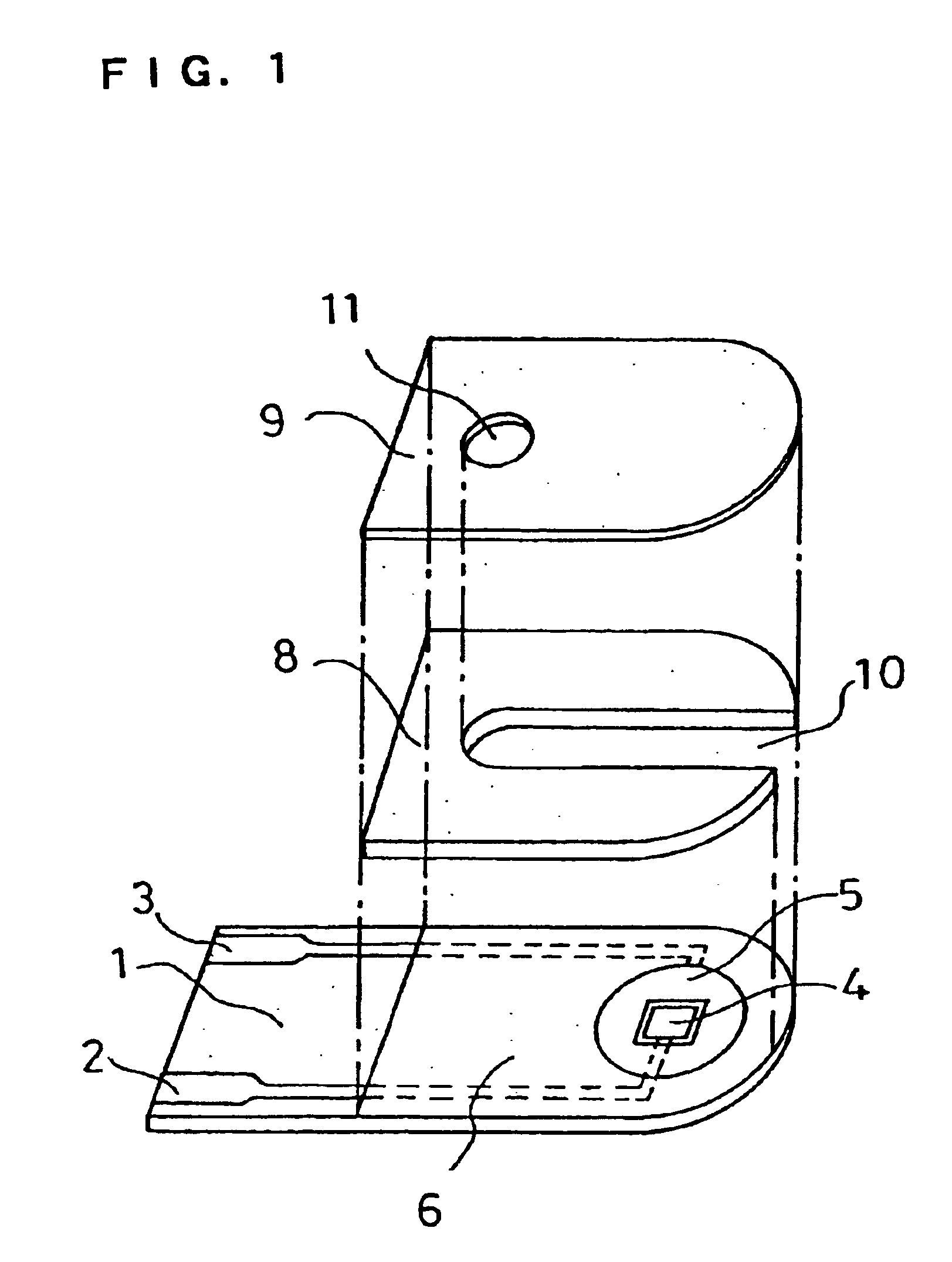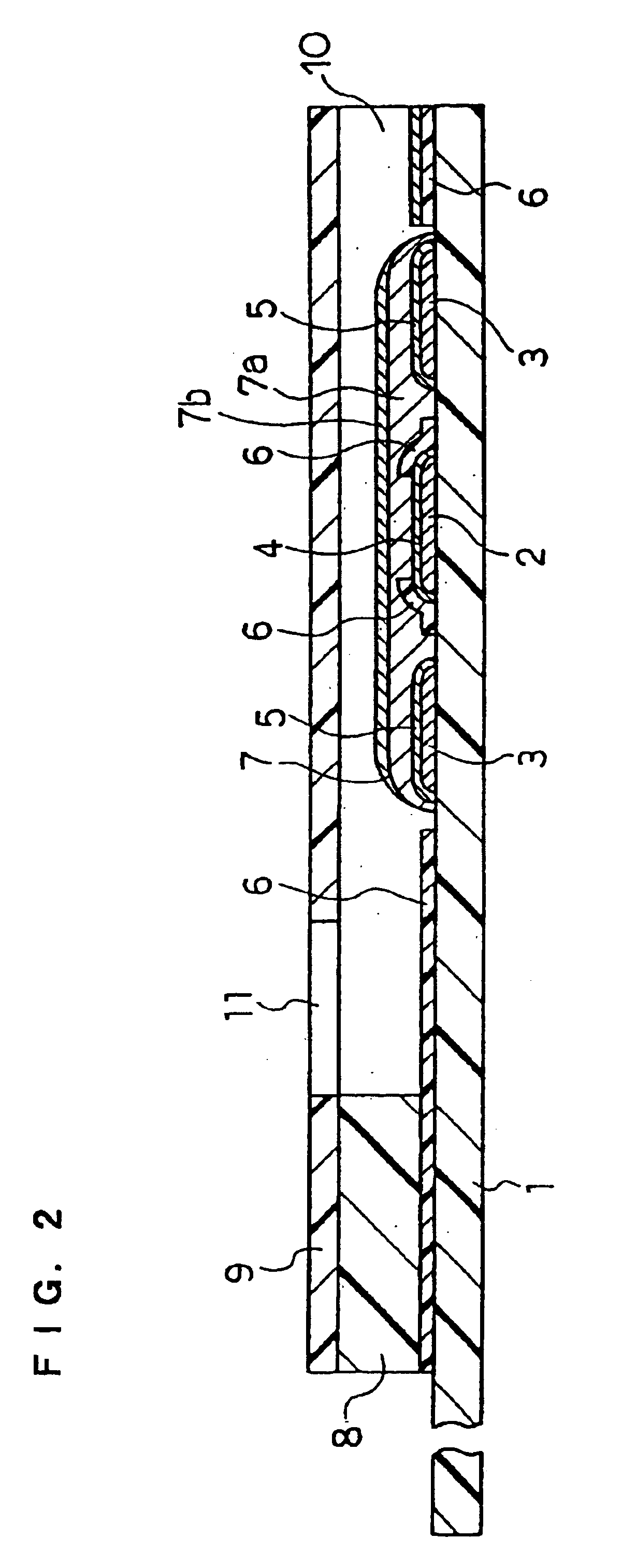Biosensor
a biosensor and sensor technology, applied in the field of biosensors, can solve the problems of longer measurement time, increase the amount of electron mediators supplied, increase the accuracy of measurement, and increase the response.
- Summary
- Abstract
- Description
- Claims
- Application Information
AI Technical Summary
Benefits of technology
Problems solved by technology
Method used
Image
Examples
example 2
In the same manner as in Example 1, the CMC layer 7a and the layer 7b containing GOD, GLN and potassium ferricyanide were formed over the electrode system on the base plate 1. This example does not use the spacer 8 and the cover 9.
Over the reagent system 7 of the sensor was dropped an aqueous solution containing a certain amount of D-glucose. The amount of the D-glucose aqueous solution dropped was made a predetermined amount. After a lapse of predetermined time, a voltage of 500 mV was applied to the working electrode 4 with respect to the counter electrode 5, and the current value flowing at this time was measured. Between the response current obtained and the D-glucose concentration, a favorable linear relationship was observed. Also, the response current obtained was significantly larger than the response current obtained from the sensor not containing GLN in the reagent system 7. In this way, it was found that, even when the sensor did not have the cover member, the above-descr...
example 3
In this example, a sensor was produced in the same manner as in Example 1, except that a pH buffer composed of a combination of dipotassium hydrogenphosphate (K.sub.2 HPO.sub.4) and potassium dihydrogenphosphate (KH.sub.2 PO.sub.4) was added to the layer 7b such that the pH realized by water introduction became 7.
An aqueous solution containing a certain amount of D-glucose was supplied to the opening of the sample solution supply pathway, and after a lapse of predetermined time, a voltage of 500 mV was applied to the working electrode 4 with respect to the counter electrode 5 and the current value flowing at this time was measured. The response current obtained was higher than that of the sensor of the Example 1 not containing a pH buffer in the reagent system 7. This result was obtained presumably because, due to the addition of the pH buffer, the pH of the sample solution was maintained at a value at which GLN more effectively decomposed D-glucono-.delta.-lactone. It is considered...
example 4
In this example, a sensor was produced in the same manner as in Example 1, except that PQQ dependent glucose dehydrogenase (hereinafter referred to as PQQ-GDH) was used in place of the enzyme GOD of the layer 7b. The ratio of the activity unit number of GLN to PQQ-GDH was GLN:PQQ-GDH=2:1. The amount of PQQ-GDH used was 2 units.
An aqueous solution containing a certain amount of D-glucose was supplied to the opening of the sample solution supply pathway of the sensor, and after a lapse of predetermined time, a voltage of 500 mV was applied to the working electrode 4 with respect to the counter electrode 5 and the current value flowing at this time was measured. The response current obtained exhibited a favorable linear relationship with respect to the concentration of D-glucose. Also, for comparison, a sensor not containing GLN in the reagent system 7 was produced and the response value was measured in the same manner as above. In each glucose concentration, the response of the sensor...
PUM
| Property | Measurement | Unit |
|---|---|---|
| voltage | aaaaa | aaaaa |
| concentrations | aaaaa | aaaaa |
| concentrations | aaaaa | aaaaa |
Abstract
Description
Claims
Application Information
 Login to View More
Login to View More - R&D
- Intellectual Property
- Life Sciences
- Materials
- Tech Scout
- Unparalleled Data Quality
- Higher Quality Content
- 60% Fewer Hallucinations
Browse by: Latest US Patents, China's latest patents, Technical Efficacy Thesaurus, Application Domain, Technology Topic, Popular Technical Reports.
© 2025 PatSnap. All rights reserved.Legal|Privacy policy|Modern Slavery Act Transparency Statement|Sitemap|About US| Contact US: help@patsnap.com



